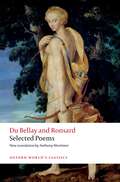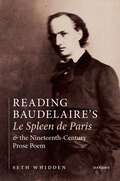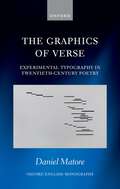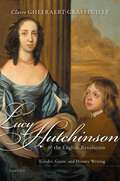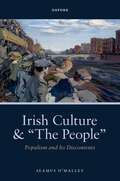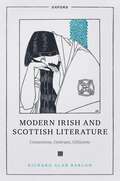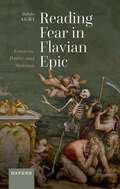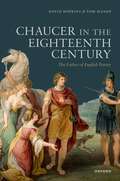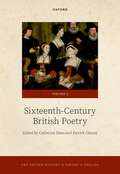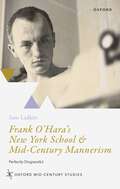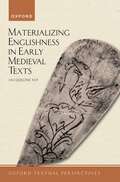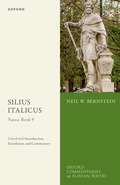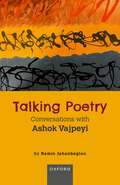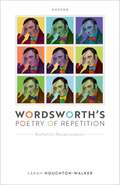- Table View
- List View
Selected Poems (Oxford World's Classics)
by Du Bellay Ronsard'Live now and listen, do not wait in vain Until tomorrow; pluck life's rose today.' Joachim du Bellay and Pierre de Ronsard are two of the major sixteenth-century French poets and leaders of the extraordinary group known as 'La Pléiade'. Determined to create a national vernacular literature, the Pléiade poets profited from an intense study of Greek and Roman models and from a creative use of classical mythology to produce a body of verse that reflects the vigour and variety of European Renaissance culture. Du Bellay broke new ground with the gritty realism and resentment of the Regrets and with his meditation in the Antiquities on the rise and fall of the Roman Empire. In a series of sonnet sequences (Cassandre, Marie, Astrée, Hélène) Ronsard developed the Petrarchan tradition of love poetry with a wider range of situations, a richer imagery, and more robust sensuality. His reputation as France's greatest love-poet should not, however, obscure his excellence in an astonishing variety of forms and genres such as elegies, odes, philosophical hymns, and religious controversy. Anthony Mortimer's verse translations cover this many-faceted achievement in a version that functions as English poetry in its own right without departing from the letter and spirit of the original. The French text is given on facing pages and a useful appendix contains extracts from seminal manifestos by the two poets. A critical introduction, a glossary of names and places, and abundant notes encourage the reader to place the poems in their social and cultural context. ABOUT THE SERIES: For over 100 years Oxford World's Classics has made available the widest range of literature from around the globe. Each affordable volume reflects Oxford's commitment to scholarship, providing the most accurate text plus a wealth of other valuable features, including expert introductions by leading authorities, helpful notes to clarify the text, up-to-date bibliographies for further study, and much more.
Selected Poems (Oxford World's Classics)
by Du Bellay Ronsard'Live now and listen, do not wait in vain Until tomorrow; pluck life's rose today.' Joachim du Bellay and Pierre de Ronsard are two of the major sixteenth-century French poets and leaders of the extraordinary group known as 'La Pléiade'. Determined to create a national vernacular literature, the Pléiade poets profited from an intense study of Greek and Roman models and from a creative use of classical mythology to produce a body of verse that reflects the vigour and variety of European Renaissance culture. Du Bellay broke new ground with the gritty realism and resentment of the Regrets and with his meditation in the Antiquities on the rise and fall of the Roman Empire. In a series of sonnet sequences (Cassandre, Marie, Astrée, Hélène) Ronsard developed the Petrarchan tradition of love poetry with a wider range of situations, a richer imagery, and more robust sensuality. His reputation as France's greatest love-poet should not, however, obscure his excellence in an astonishing variety of forms and genres such as elegies, odes, philosophical hymns, and religious controversy. Anthony Mortimer's verse translations cover this many-faceted achievement in a version that functions as English poetry in its own right without departing from the letter and spirit of the original. The French text is given on facing pages and a useful appendix contains extracts from seminal manifestos by the two poets. A critical introduction, a glossary of names and places, and abundant notes encourage the reader to place the poems in their social and cultural context. ABOUT THE SERIES: For over 100 years Oxford World's Classics has made available the widest range of literature from around the globe. Each affordable volume reflects Oxford's commitment to scholarship, providing the most accurate text plus a wealth of other valuable features, including expert introductions by leading authorities, helpful notes to clarify the text, up-to-date bibliographies for further study, and much more.
Reading Baudelaire's Le Spleen de Paris and the Nineteenth-Century Prose Poem
by Seth WhiddenThrough its readings of Charles Baudelaire's collection Le Spleen de Paris and other prose poems from the nineteenth century, this book considers the practice of reading prose poetry and how it might be different from reading poetry in verse. Among the numerous factors that helped shape the nascent modernity in Baudelaire's poetic prose are the poems' themes, forms, linguistic qualities, and modes. The contradictions identifiable at the level of prose poetry's discourse are similarly perceptible in other aspects of Baudelaire's poetic language, beyond the discursive: in the poems' formal considerations, which retain recognisable traces of verse despite their prose presentation; and, with respect to both poetic form and thematics, in the sights and sounds that contribute to their poeticity. With a focus on what makes prose texts poetic, this study sheds light on Baudelaire the practitioner of the prose poem, as he navigated and complicated the boundaries between verse, prose, and poetry. Rather than rejecting those categories, Baudelaire forges a poetic space in which the notions of poetry and prose are recast, juxtaposed in a delicate balance in a textual space they manage to share. This coexistence of poetry and prose—previously thought of as incompatible—is the underlying tension and framework that contributes importantly to the modernity of his prose poetry. In turn, this new mode of poetry calls for new modes of reading poetry and new ways of engaging with a text.
Reading Baudelaire's Le Spleen de Paris and the Nineteenth-Century Prose Poem
by Seth WhiddenThrough its readings of Charles Baudelaire's collection Le Spleen de Paris and other prose poems from the nineteenth century, this book considers the practice of reading prose poetry and how it might be different from reading poetry in verse. Among the numerous factors that helped shape the nascent modernity in Baudelaire's poetic prose are the poems' themes, forms, linguistic qualities, and modes. The contradictions identifiable at the level of prose poetry's discourse are similarly perceptible in other aspects of Baudelaire's poetic language, beyond the discursive: in the poems' formal considerations, which retain recognisable traces of verse despite their prose presentation; and, with respect to both poetic form and thematics, in the sights and sounds that contribute to their poeticity. With a focus on what makes prose texts poetic, this study sheds light on Baudelaire the practitioner of the prose poem, as he navigated and complicated the boundaries between verse, prose, and poetry. Rather than rejecting those categories, Baudelaire forges a poetic space in which the notions of poetry and prose are recast, juxtaposed in a delicate balance in a textual space they manage to share. This coexistence of poetry and prose—previously thought of as incompatible—is the underlying tension and framework that contributes importantly to the modernity of his prose poetry. In turn, this new mode of poetry calls for new modes of reading poetry and new ways of engaging with a text.
The Graphics of Verse: Experimental Typography in Twentieth-Century Poetry (Oxford English Monographs)
by Daniel MatoreIs poetry a visual art? Why do the pages of nineteenth-century poetry look so different to those of twentieth-century verse? Exploiting the expressive possibilities of print—from spacing and indentation to alignment and typeface—is one of the defining ways in which poetry was modernized in the twentieth century. While the visual experiments of European poets have been well documented, the typographical explorations of poets writing in English have been largely neglected. This volume confronts a major unanswered question: why did British and American poets, from the beginning of the twentieth century right up to the present day, choose to experiment with the design and lay-out of the printed page? This book aims to provide the first detailed account of this lineage of literary style, examining the poetry and criticism of figures such as Ezra Pound, Hope Mirrlees, William Carlos Williams, E.E. Cummings, Marianne Moore, David Jones, Denise Levertov, Charles Olson, Frances Motz Boldereff, and J.H. Prynne. It draws on unpublished archival materials to show how poets began to draft, sketch, and compose in new and eccentric ways as they annexed the roles of book designer and printer. Typography, it argues, was instrumental in debates about metre, free verse, and the nature of poetry as poems morphed into scores, slogans, maps, and signs. It investigates how the typography of poetry was animated by musicology, psychophysics, linguistics, politics, ophthalmology, cartography, and advertising.
The Graphics of Verse: Experimental Typography in Twentieth-Century Poetry (Oxford English Monographs)
by Daniel MatoreIs poetry a visual art? Why do the pages of nineteenth-century poetry look so different to those of twentieth-century verse? Exploiting the expressive possibilities of print—from spacing and indentation to alignment and typeface—is one of the defining ways in which poetry was modernized in the twentieth century. While the visual experiments of European poets have been well documented, the typographical explorations of poets writing in English have been largely neglected. This volume confronts a major unanswered question: why did British and American poets, from the beginning of the twentieth century right up to the present day, choose to experiment with the design and lay-out of the printed page? This book aims to provide the first detailed account of this lineage of literary style, examining the poetry and criticism of figures such as Ezra Pound, Hope Mirrlees, William Carlos Williams, E.E. Cummings, Marianne Moore, David Jones, Denise Levertov, Charles Olson, Frances Motz Boldereff, and J.H. Prynne. It draws on unpublished archival materials to show how poets began to draft, sketch, and compose in new and eccentric ways as they annexed the roles of book designer and printer. Typography, it argues, was instrumental in debates about metre, free verse, and the nature of poetry as poems morphed into scores, slogans, maps, and signs. It investigates how the typography of poetry was animated by musicology, psychophysics, linguistics, politics, ophthalmology, cartography, and advertising.
Lucy Hutchinson and the English Revolution: Gender, Genre, and History Writing
by Claire Gheeraert-GraffeuilleIn Lucy Hutchinson and the English Revolution, Claire Gheeraert-Graffeuille explores Lucy Hutchinson's historical writings and the Memoirs of the Life of Colonel Hutchinson, which, although composed between 1664 and 1667, were first published in 1806. The Memoirs were a best-seller in the nineteenth century, but largely fell into oblivion in the twentieth century. They were rediscovered in the late 1980s by historians and literary scholars interested in women's writing, the emerging culture of republicanism, and dissent. By approaching the Memoirs through the prism of history and form, this book challenges the widely-held assumption that early modern women did not - and could not - write the history of wars, a field that was supposedly gendered as masculine. On the contrary, Gheeraert-Graffeuille shows that Lucy Hutchinson, a reader of ancient history and an outstanding Latinist, was a historian of the English Revolution, to be ranked alongside Richard Baxter, Edmund Ludlow, and Edward Hyde.
Lucy Hutchinson and the English Revolution: Gender, Genre, and History Writing
by Claire Gheeraert-GraffeuilleIn Lucy Hutchinson and the English Revolution, Claire Gheeraert-Graffeuille explores Lucy Hutchinson's historical writings and the Memoirs of the Life of Colonel Hutchinson, which, although composed between 1664 and 1667, were first published in 1806. The Memoirs were a best-seller in the nineteenth century, but largely fell into oblivion in the twentieth century. They were rediscovered in the late 1980s by historians and literary scholars interested in women's writing, the emerging culture of republicanism, and dissent. By approaching the Memoirs through the prism of history and form, this book challenges the widely-held assumption that early modern women did not - and could not - write the history of wars, a field that was supposedly gendered as masculine. On the contrary, Gheeraert-Graffeuille shows that Lucy Hutchinson, a reader of ancient history and an outstanding Latinist, was a historian of the English Revolution, to be ranked alongside Richard Baxter, Edmund Ludlow, and Edward Hyde.
Irish Culture and “The People”: Populism and its Discontents
by Seamus O'MalleyThis book argues that populism has been a shaping force in Irish literary culture. Populist moments and movements have compelled authors to reject established forms and invent new ones. Sometimes, as in the middle period of W.B. Yeats's work, populism forces a writer into impossible stances, spurring ever greater rhetorical and poetic creativity. At other times, as in the critiques of Anna Parnell or Myles na gCopaleen, authors penetrate the rhetoric fog of populist discourse and expose the hollowness of its claims. Yet in both politics and culture, populism can be a generative force. Daniel O'Connell, and later the Land League, utilized populist discourse to advance Irish political freedom and expand rights. The most powerful works of Lady Gregory and Ernie O'Malley are their portraits of The People that borrows from the populist vocabulary. While we must be critical of populist discourse, we dismiss it at our loss. This study synthesizes existing scholarship on populism to explore how Irish texts have evoked "The People"—a crucial rhetorical move for populist discourse—and how some writers have critiqued, adopted, and adapted the languages of Irish populisms.
Irish Culture and The People: Populism and its Discontents
by Seamus O'MalleyThis book argues that populism has been a shaping force in Irish literary culture. Populist moments and movements have compelled authors to reject established forms and invent new ones. Sometimes, as in the middle period of W.B. Yeats's work, populism forces a writer into impossible stances, spurring ever greater rhetorical and poetic creativity. At other times, as in the critiques of Anna Parnell or Myles na gCopaleen, authors penetrate the rhetoric fog of populist discourse and expose the hollowness of its claims. Yet in both politics and culture, populism can be a generative force. Daniel O'Connell, and later the Land League, utilized populist discourse to advance Irish political freedom and expand rights. The most powerful works of Lady Gregory and Ernie O'Malley are their portraits of The People that borrows from the populist vocabulary. While we must be critical of populist discourse, we dismiss it at our loss. This study synthesizes existing scholarship on populism to explore how Irish texts have evoked "The People"—a crucial rhetorical move for populist discourse—and how some writers have critiqued, adopted, and adapted the languages of Irish populisms.
Modern Irish and Scottish Literature: Connections, Contrasts, Celticisms
by Richard Alan BarlowModern Irish and Scottish Literature: Connections, Contrasts, Celticisms explores the ways Irish and Scottish literatures have influenced each other from the 1760s onwards. Although an early form of Celticism disappeared with the demise of the Celtic Revivals of Ireland and Scotland, the 'Celtic world' and the 'Celtic temperament' remained key themes in central texts of Irish and Scottish literature well into the twentieth century. Richard Barlow examines the emergence, development, and transformation of Celticism within Irish and Scottish writing and identifies key connections between modern Irish and Scottish authors and texts. By reading works from figures such as James Macpherson, Walter Scott, Sydney Owenson, Augusta Gregory, W. B. Yeats, Fiona Macleod, James Joyce, Samuel Beckett, Hugh MacDiarmid, Sorley MacLean, and Seamus Heaney in their political and cultural contexts, Barlow provides a new account of the characteristics and phases of literary Celticism within Romanticism, Modernism, and beyond.
Modern Irish and Scottish Literature: Connections, Contrasts, Celticisms
by Richard Alan BarlowModern Irish and Scottish Literature: Connections, Contrasts, Celticisms explores the ways Irish and Scottish literatures have influenced each other from the 1760s onwards. Although an early form of Celticism disappeared with the demise of the Celtic Revivals of Ireland and Scotland, the 'Celtic world' and the 'Celtic temperament' remained key themes in central texts of Irish and Scottish literature well into the twentieth century. Richard Barlow examines the emergence, development, and transformation of Celticism within Irish and Scottish writing and identifies key connections between modern Irish and Scottish authors and texts. By reading works from figures such as James Macpherson, Walter Scott, Sydney Owenson, Augusta Gregory, W. B. Yeats, Fiona Macleod, James Joyce, Samuel Beckett, Hugh MacDiarmid, Sorley MacLean, and Seamus Heaney in their political and cultural contexts, Barlow provides a new account of the characteristics and phases of literary Celticism within Romanticism, Modernism, and beyond.
Reading Fear in Flavian Epic: Emotion, Power, and Stoicism
by Dalida AgriThis book examines the textual representations of emotions, fear in particular, through the lens of Stoic thought and their impact on depictions of power, gender, and agency. It first draws attention to the role and significance of fear, and cognate emotions, in the tyrant's psyche, and then goes on to explore how these emotions, in turn, shape the wider narratives. The focus is on the lengthy epics of Valerius Flaccus' Argonautica, Statius' Thebaid, and Silius Italicus' Punica. All three poems are obsessed with men in power with no power over themselves, a marked concern that carries a strong Senecan fingerprint. Seneca's influence on post-Neronian epic can be felt beyond his plays. His Epistles and other prose works prove particularly illuminating for each of the poet's gendered treatment of the relationship between power and emotion. By adopting a Roman Stoic perspective, both philosophical and cultural, this study brings together a cluster of major ideas to draw meaningful connections and unlock new readings.
Reading Fear in Flavian Epic: Emotion, Power, and Stoicism
by Dalida AgriThis book examines the textual representations of emotions, fear in particular, through the lens of Stoic thought and their impact on depictions of power, gender, and agency. It first draws attention to the role and significance of fear, and cognate emotions, in the tyrant's psyche, and then goes on to explore how these emotions, in turn, shape the wider narratives. The focus is on the lengthy epics of Valerius Flaccus' Argonautica, Statius' Thebaid, and Silius Italicus' Punica. All three poems are obsessed with men in power with no power over themselves, a marked concern that carries a strong Senecan fingerprint. Seneca's influence on post-Neronian epic can be felt beyond his plays. His Epistles and other prose works prove particularly illuminating for each of the poet's gendered treatment of the relationship between power and emotion. By adopting a Roman Stoic perspective, both philosophical and cultural, this study brings together a cluster of major ideas to draw meaningful connections and unlock new readings.
Chaucer in the Eighteenth Century: The Father of English Poetry
by David Hopkins Tom MasonThis volume is a study of how the poetry of Chaucer continued to give pleasure in the eighteenth century despite the immense linguistic, literary, and cultural shifts that had occurred in the intervening centuries. It explores translations and imitations of Chaucer's work by Dryden, Pope, and other poets (including Samuel Cobb, John Dart, Christopher Smart, Jane Brereton, William Wordsworth, and Leigh Hunt) from the early eighteenth to the early nineteenth centuries, as well as investigating the beginnings of modern Chaucer editing and biography. It pays particular attention to critical responses to Chaucer by Dryden and the brothers Warton, and includes a chapter on the oblique presence of Chaucer in Samuel Johnson's Dictionary. It explores the ways in which Chaucer's poetry (including several works now known not to be by him) was described, refashioned, reimagined, and understood several centuries after its initial appearance. It also documents the way that views of Chaucer's own character were inferred from his work. The book combines detailed discussion of particular critical and poetic texts, many of them unfamiliar to modern readers, with larger suggestions about the ways in which poetry of the past is received in the future.
Chaucer in the Eighteenth Century: The Father of English Poetry
by David Hopkins Tom MasonThis volume is a study of how the poetry of Chaucer continued to give pleasure in the eighteenth century despite the immense linguistic, literary, and cultural shifts that had occurred in the intervening centuries. It explores translations and imitations of Chaucer's work by Dryden, Pope, and other poets (including Samuel Cobb, John Dart, Christopher Smart, Jane Brereton, William Wordsworth, and Leigh Hunt) from the early eighteenth to the early nineteenth centuries, as well as investigating the beginnings of modern Chaucer editing and biography. It pays particular attention to critical responses to Chaucer by Dryden and the brothers Warton, and includes a chapter on the oblique presence of Chaucer in Samuel Johnson's Dictionary. It explores the ways in which Chaucer's poetry (including several works now known not to be by him) was described, refashioned, reimagined, and understood several centuries after its initial appearance. It also documents the way that views of Chaucer's own character were inferred from his work. The book combines detailed discussion of particular critical and poetic texts, many of them unfamiliar to modern readers, with larger suggestions about the ways in which poetry of the past is received in the future.
The Oxford History of Poetry in English: Volume 4. Sixteenth-Century British Poetry (Oxford History of Poetry in English)
The Oxford History of Poetry in English is designed to offer a fresh, multi-voiced, and comprehensive analysis of 'poetry': from Anglo-Saxon culture through contemporary British, Irish, American, and Global culture, including English, Scottish, and Welsh poetry, Anglo-American colonial and post-colonial poetry, and poetry in Canada, Australia, New Zealand, the Caribbean, India, Africa, Asia, and other international locales. The series both synthesises existing scholarship and presents cutting-edge research, employing a global team of expert contributors for each of the volumes. Sixteenth-Century British Poetry features a history of the birth moment of modern 'English' poetry in greater detail than previous studies. It examines the literary transitions, institutional contexts, artistic practices, and literary genres within which poets compose their works. Each chapter combines an orientation to its topic and a contribution to the field. Specifically, the volume introduces a narrative about the advent of modern English poetry from Skelton to Spenser, attending to the events that underwrite the poets' achievements: Humanism; Reformation; monarchism and republicanism; colonization; print and manuscript; theatre; science; and companionate marriage. Featured are metre and form, figuration and allusiveness, and literary career, as well as a wide range of poets, from Wyatt, Surrey, and Isabella Whitney to Ralegh, Drayton, and Mary Herbert. Major works discussed include Sidney's Astrophil and Stella, Spenser's Faerie Queene, Marlowe's Hero and Leander, and Shakespeare's Sonnets.
The Oxford History of Poetry in English: Volume 4. Sixteenth-Century British Poetry (Oxford History of Poetry in English)
by Catherine Bates Patrick CheneyThe Oxford History of Poetry in English is designed to offer a fresh, multi-voiced, and comprehensive analysis of 'poetry': from Anglo-Saxon culture through contemporary British, Irish, American, and Global culture, including English, Scottish, and Welsh poetry, Anglo-American colonial and post-colonial poetry, and poetry in Canada, Australia, New Zealand, the Caribbean, India, Africa, Asia, and other international locales. The series both synthesises existing scholarship and presents cutting-edge research, employing a global team of expert contributors for each of the volumes. Sixteenth-Century British Poetry features a history of the birth moment of modern 'English' poetry in greater detail than previous studies. It examines the literary transitions, institutional contexts, artistic practices, and literary genres within which poets compose their works. Each chapter combines an orientation to its topic and a contribution to the field. Specifically, the volume introduces a narrative about the advent of modern English poetry from Skelton to Spenser, attending to the events that underwrite the poets' achievements: Humanism; Reformation; monarchism and republicanism; colonization; print and manuscript; theatre; science; and companionate marriage. Featured are metre and form, figuration and allusiveness, and literary career, as well as a wide range of poets, from Wyatt, Surrey, and Isabella Whitney to Ralegh, Drayton, and Mary Herbert. Major works discussed include Sidney's Astrophil and Stella, Spenser's Faerie Queene, Marlowe's Hero and Leander, and Shakespeare's Sonnets.
Frank O'Hara's New York School and Mid-Century Mannerism: Perfectly Disgraceful (Oxford Mid-Century Studies Series)
by Sam LadkinFrank O'Hara's New York School and Mid-Century Mannerism offers a ground-breaking account of the poet Frank O'Hara and the extraordinary cultural blossoming O'Hara catalysed, namely the mid-century experimental and multi-disciplinary arts scene, the New York School. Fresh accounts of canonical figures (Jackson Pollock, Willem de Kooning, George Balanchine, Fred Astaire) and original work on those too little discussed (Edwin Denby, Elaine de Kooning) resound with analysis of queer iconology from Michelangelo's David to James Dean. Sam Ladkin argues that O'Hara and the New York School revive Mannerism. Turning away from interpretations of O'Hara's Transcendentalism, Romanticism, or pastoralism, 'mid-century Mannerism' helps explain O'Hara's self-conscious style, its play with sweet and grand grace, contortion of conventional measure, risks with affectation, conceits, nonchalance, and scrambling of high/low culture. Mannerism clarifies the sociability implicit in the formal innovations of the New York School. The work also studies the kinship between art mediums by retooling rhetoric and recovering a perennial manneristic tendency beyond period style. Genealogies of grace, the figura serpentinata, sprezzatura, ornatus, and the marvellous exemplify qualities exhibited by O'Hara's New York School. Ladkin relates the essential role of dance in the New York School. O'Hara's reception has been tied to painting, predominantly Abstract Expressionism. He was also, however, a balletomane, a fan, for whom ballet was 'made up exclusively of qualities which other arts only aspire to in order to be truly modern.' Relaying ballet's Mannerist origins and aesthetics, and demonstrating its influence alongside Broadway and Hollywood musical-dance on art and poetry, completes the portrait of mid-century modernity.
Frank O'Hara's New York School and Mid-Century Mannerism: Perfectly Disgraceful (Oxford Mid-Century Studies Series)
by Sam LadkinFrank O'Hara's New York School and Mid-Century Mannerism offers a ground-breaking account of the poet Frank O'Hara and the extraordinary cultural blossoming O'Hara catalysed, namely the mid-century experimental and multi-disciplinary arts scene, the New York School. Fresh accounts of canonical figures (Jackson Pollock, Willem de Kooning, George Balanchine, Fred Astaire) and original work on those too little discussed (Edwin Denby, Elaine de Kooning) resound with analysis of queer iconology from Michelangelo's David to James Dean. Sam Ladkin argues that O'Hara and the New York School revive Mannerism. Turning away from interpretations of O'Hara's Transcendentalism, Romanticism, or pastoralism, 'mid-century Mannerism' helps explain O'Hara's self-conscious style, its play with sweet and grand grace, contortion of conventional measure, risks with affectation, conceits, nonchalance, and scrambling of high/low culture. Mannerism clarifies the sociability implicit in the formal innovations of the New York School. The work also studies the kinship between art mediums by retooling rhetoric and recovering a perennial manneristic tendency beyond period style. Genealogies of grace, the figura serpentinata, sprezzatura, ornatus, and the marvellous exemplify qualities exhibited by O'Hara's New York School. Ladkin relates the essential role of dance in the New York School. O'Hara's reception has been tied to painting, predominantly Abstract Expressionism. He was also, however, a balletomane, a fan, for whom ballet was 'made up exclusively of qualities which other arts only aspire to in order to be truly modern.' Relaying ballet's Mannerist origins and aesthetics, and demonstrating its influence alongside Broadway and Hollywood musical-dance on art and poetry, completes the portrait of mid-century modernity.
Materializing Englishness in Early Medieval Texts (Oxford Textual Perspectives)
by Jacqueline FayThe aim of this book is to restore to the story of Englishness the lively material interactions between words, bodies, plants, stones, metals, and soil, among other things, that would have characterized it for the early medieval English themselves. In particular, each chapter demonstrates how a productive collapse, or fusion, between place and history happens not only in the intellectual realm, in ideas, but is also a material concern, becoming enfleshed in encounters between early medieval bodies and a host of material entities. Through readings of texts in a wide variety of genres including hagiography, heroic poetry, and medical and historical works, the book argues that Englishness during this period is an embodied identity emergent at the frontier of material and textual interactions that serve productively to occlude history, religion, and geography. The early medieval English body thus results from the rich encounter between the lived environment—climate, soil, landscape features, plants—and the textual-discursive realm that both determines what that environment means and is also itself determined by the material constraints of everyday life.
Silius Italicus: Edited with Introduction, Translation, and Commentary (Oxford Commentaries on Flavian Poetry)
by Neil W. BernsteinBook 9 of Silius Italicus' first-century Latin epic poem Punica begins the narrative of the Battle of Cannae (August 216 BC). This book is an integral part of the epic's three-book movement that narrates one of the largest battles in Roman history. It opens with the dispute between the consuls Paulus and Varro over giving battle, in the face of hostile omens and Hannibal's record of successful combat. On the eve of the battle, the Roman soldier Solymus accidentally kills his father Satricus, thereby presenting an omen of disaster for the Roman army. After Hannibal and Varro encourage their troops, the initial phase of the battle commences. The gods descend to the battlefield, and Mars and Minerva fight the sole full-scale theomachy in Latin epic. Aeolus summons the Vulturnus wind at Juno's request to devastate the Roman ranks. After the gods have departed, Hannibal's elephant troops advance and scatter the Roman forces. The book ends by recapitulating the opening episode: Varro admits his mistake in giving battle and flees the battlefield. This volume is the first full-scale commentary in English devoted exclusively to Punica 9. It features the Latin text with a critical apparatus and a parallel English translation. Detailed commentary notes provide information on literary style, use of language, poetic intertexts, and scholarly interpretation. The Introduction offers further context and background, including sections on Silius Italicus and his era, the historiographic and rhetorical traditions that he adopted, the inter- and intra-textuality of the Cannae episode, and the book's use of diction and metre.
Talking Poetry: Conversations with Ashoke Vajpeyi
by Ramin JahanbeglooThis is an interesting book of conversations, which not only endorses the life and thoughts of Ashok Vajpeyi, but also praises poetry in general. Ashok Vajpeyi is a poet who is at home with the word. He speaks to the mortals and the divinities. He makes the mystery of the world visible to us by speaking with/of poetry. Throughout these conversations we encounter a poet who sets his own pace through poetry, music and painting. Ashok Vajpeyi's deep sense of expectation from arts is born out of his love of the world, which renders moral dignity to creativity.
Talking Poetry: Conversations with Ashoke Vajpeyi
by Ramin JahanbeglooThis is an interesting book of conversations, which not only endorses the life and thoughts of Ashok Vajpeyi, but also praises poetry in general. Ashok Vajpeyi is a poet who is at home with the word. He speaks to the mortals and the divinities. He makes the mystery of the world visible to us by speaking with/of poetry. Throughout these conversations we encounter a poet who sets his own pace through poetry, music and painting. Ashok Vajpeyi's deep sense of expectation from arts is born out of his love of the world, which renders moral dignity to creativity.
Wordsworth's Poetry of Repetition: Romantic Recapitulation
by Sarah Houghton-WalkerRepetition has connotations of something boring, or unoriginal, or lacking in poetic skill, but repetition - in several different senses - dominates Wordsworth's poetry. This book explores those moments of repetition, placing them in the early nineteenth century context from which they emerged, and teasing out through extended close attention to the poetry itself the complexities of repetition and recapitulation. Drawing on extensive close readings of Wordsworth's poetry, the book asks what it means to repeat, and how saying things again, often in a way which recognises both sameness and difference at the same time, is fundamental to Wordsworth's attempt to write what he called 'sincere' verse. By analysing instances of repetition and the conjunctions which facilitate recapitulation within Wordsworth's writing, the book attempts to understand the context, in terms of ideas of repetition, from which Wordsworth's works emerge, and to consider repetition in a broad range of senses - from repeated words and sounds within particular poems, to ideas of translation, allusion, and echo. Houghton-Walker also argues the importance of the element of difference within even apparently 'pure' repetition. Such difference might be in perception, attitude, or understanding, but for Wordsworth, the subtle relationship between instances of what seems to be the same experience illuminates the potential for poetry to portray simultaneously the specific and the universal: to hold within its lines both immediate and general truths at the same time.
